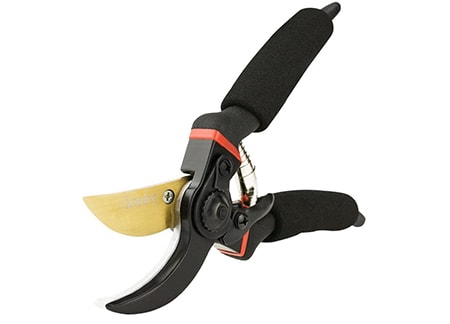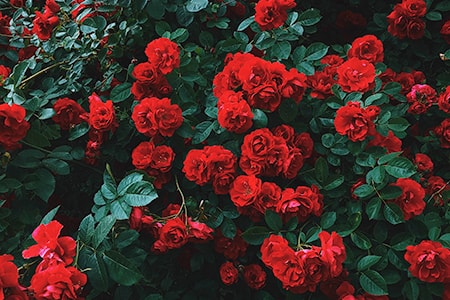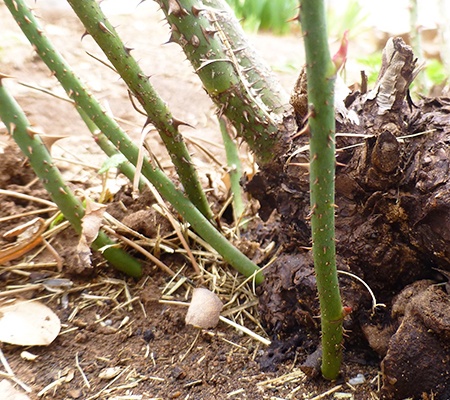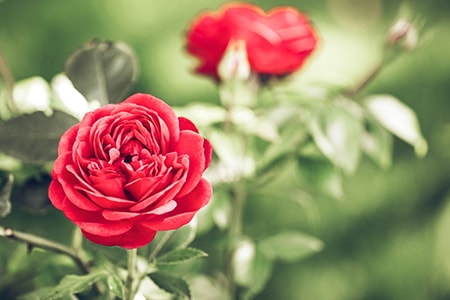How to Prune Roses to Encourage Better Growth & Health
Author: Jen Worst | Editor: Omar Alonso
Review & Research: Jen Worst & Chris Miller

Anyone can whip out some scissors and start pruning roses, but that doesn't mean they know how to prune roses correctly. Doing it right means causing little harm while actually encouraging new growth.
There's very little out there that's more beautiful than a rose in full bloom. These gorgeous, and heavenly-scented flowers are not as complicated to grow and prune as it may seem.
Today we'll walk through the exact process of when to prune, how to do it, and how to know which roses to take action on. Beyond that, we'll then offer a bunch of tips so you can get the most out of the process.
How to Prune Roses
One of the essential parts of taking care of roses is pruning. Pruning is a trimming process involving removing any unwanted stems, failing flowers, and other issues that can effect the health and appearance of your rose bush.
Although it's counter-intuitive, pruning allows the plant to thrive. And even though some may think it'll be challenging, it's pretty simple with instructions.
Tools Needed for Pruning Roses
When pruning roses, you only need a few items:
- bypass shears
- suitable gloves
- long & heavy shirt sleeves
To protect your hands from thorns, a pair of gloves with thick pads will going to provide you the maximum protection.

What you want are bypass shears (pictured above) that are specifically notanvil shears. The anvil type can crush the canes causing damage to them, but bypass shears will cause minimal damage by creating a clean cut.
The branches and stems can all be far thicker and tougher than you're anticipating. And this means they'll also be covered in very stiff and sharp thorns. For this reason we recommend wearing a long sleeve shirt or jacket with thick sleeves.
When to Prune Roses

The best time to prune roses is after the last frost during the early spring. Any earlier can cause too much stress, leaving the bush vulnerable to temperature fluctuations.
You'll also want to prune during the summer season. But we're not talking about any heavy-duty work at this point. You'll just want to removing any dead flowers and broken branches. Doing so will encourage even more growth, flower production, and blossoms.
Finally, when the first frost heading into winter happens, you'll want to prune the long stems of your rose plants and the cross branches as they can damage the plant in strong winds later and they'll eat up too much excess nutrients and energy when preservation is needed in the coldest months.
Pruning Roses

Here is a step by step guide on how to prune roses correctly. Not only does having the right shears matter but so do the techniques you use and the locations you make the cuts.
Step 1 - Prune Dead Branches for Air Circulation
When the spring season starts and the last frost has occurred, take a good look at your plant's shape. Start pruning from the bottom portion and then move to the higher sections. Get rid of all the dead canes crowding and making air circulation difficult in the middle.
Step 2 - Cut Back Newer Growth
Select an older branch (typically thicker than others) from your plant and follow it upwards it until you reach healthy, newer growth of a greener color. Cut at an angle of 45 degrees near the beginning of this new growth.
Cut through the wood and then check to see if you can see white flesh on the inside. This is a sign of a healthy plant and a cut at a proper location.
Step 3 - Remove Thin, Weak Branches
Make sure to get rid of all the canes that have grown thin. These branches aren't going to produce full-bloom roses and will simply divert energy away from healthier growth, causing the entire bush to be weaker.
Step 4 - Remove or Cut Back Grafted Rose Suckers

If you see any sucker around your rose bush, make sure to cut them off. Suckers are grown from grafted branches, often below the soil coming out of the rootstock. They usually appear as a new growth, coming up vertically from the central plant cane below the bud union.
It's essential to remove these suckers as they grow inferior flowers and can place extra stress on the root system as they turn into entirely additional bushes, creating extra demand on the roots and soil.
Step 5 - Shape the Rose Bush for a Nice Appearance
At this point, you simply want to prune the recent growth to make the bush look lovelier. It's all about appearances at this point.
The growth of the new stems is usually occurring at the bud right above the soil level, and we don't want that. Your bush will balloon out in volume and become unruly and harder to maintain.
If you do want that, you'll want to make the new stem growth in the coming seasons grow in the outward direction away from the plant. So cut again at an angle of 45 degrees leaving about 1/4 inch of the new stem. This causes the new stems to change direction into the desired pattern.
Step 6 - Dispose of All Removed Materials
After you're done with the pruning, make sure you dispose of all the dead and diseased flowers, stems, and leaves. Don't sweep or rake them up under the plant. If they remain lying around, they can harm the health of your rose bush by harboring disease and pests.
Also, if you see any significant open cuts, use white glue to seal them. These wounds are an invitation for disease which will quickly spread throughout the rest of the rose bush.
Roses are heavy feeders, so after cleaning up the plant or your roses bush, give them the nutrition they require by adding some mulch or fertilizer around the base.
A Few Tips for Pruning Roses

Here are some extra tips that will help you learn how to prune roses successfully:
It's vital to get rid of any dead wood, which is done by cutting it back to the point you reach the green part, and you see its healthy white flesh.
In many places, cane borers are a big issue. To prevent cane borers, you should cure the cuts you make by using white glue. It will make sure that your plant recovers quickly.
In a rose bush, the center must be open for maximum ventilation. Free up the center from any dead and unwanted canes. Remember, a rose bush can have volume without being dense.
Another important tip when removing branches entirely is to cut very close from the bud union. Suckers that grow, remove them as close to the bud union as possible. I don't recommend letting these thrive at all.
We never suggest using the debris removed from the plant, because you never know what kind of diseases it may be holding. Discard all of the dead leaves, flowers, stems, etc. Don't make use of them even in your compost.
If you see blooming from new growth happening, your plant will require pruning the next year right after the first frost as your plant begins to grow again.
If there is a flower bloom on the previous year's cane, make sure you let the plant flower during the season and then prune them after. Making sure you know when to prune roses is half the battle. Timing is everything.
The type of rose bushes that only bloom once require very little pruning. You can remove all the dead woods and prune to shape the stems after they are done flowering. These roses include Damask, Gallica, Alba, and Centifolia.
Roses don't usually require a lot of pruning during their flowering period; you just have to make sure to remove all the dead blooms, and picking out any sucker near the main cane. Save the serious work for the right time periods mentioned above.
Why is Pruning Roses Important?

Many people ask why they should be trimming their roses when they are getting roses. The reasons are to keep the bush from becoming unruly, to provide air circulation, to reduce risk of disease and pests, and to encourage newer and healthier growth.
Pruning Promotes Good Health
It's crucial to cut old, diseased, and damaged canes from the rose. Right before the plant starts to emerge from its dormant state, after the last frost, prune the canes back to the green portions.
If any canes are growing in the middle of the rose plant, remove them to increase ventilation. All of this reduces the risk of disease and pest infestation as well. But mainly, it causes more energy to be diverted to new growth, giving you better results later.
Your Rose Plant Will Be More Beautiful
Pruning is different for different roses; if you have the bushy modern variety of rose, then they always require this extra attention to maintain their beauty (and health). If you have the heirloom rose variety, you shouldn't be as concerned about pruning as being twiggy is their charm.
Pruning the spent flowers is essential as it promotes re-blooming. There's no way around it if you want to get the most out of your bushes.
It Keeps Them From Becoming Unruly
Roses grow wildly and may grow out of bounds. To keep them in control, pruning is essential. Over time, you'll encounter many unwanted canes, dead flowers, yellow foliage, and dead stems. It compromises the health and growth of the plant, so make sure to prune them well. It keeps their size in check, too.
That's How to Prune Roses!
Roses are a beautiful gift of nature, and you cannot say no to the eternal beauty they bring to your garden. Not to mention that their scent is fantastic. You can grow your rose bushes well once you get the hang of how to prune roses properly.
We hope that our guide was helpful for you. We aim to let the intimidated gardeners know that pruning is not something they should be scared of, as it only makes your plant thrive and grow beautifully with maximum full blooms. And that's all you need to know about how to prune roses.



